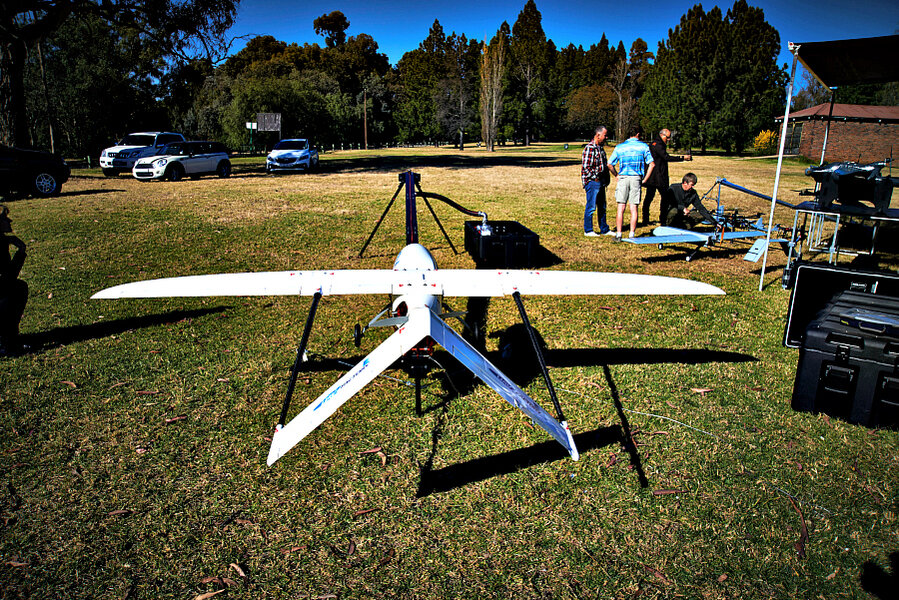An Air Shepherd to guard African wildlife
Loading...
Each year, some 40,000 elephants and more than 1,200 rhinos are killed by poachers – and experts predict that poaching activity will increase, leaving both species extinct within a decade.
Concern over how to prevent this illegal activity and protect the two species has prompted park rangers and other authorities to try a variety of enforcement and monitoring techniques.
Meanwhile, those protectors are facing threats themselves.
“They are getting shot at by poachers, and they have airplanes going down,” says John Petersen, chairman of the Lindbergh Foundation. The foundation’s namesake and legacy, famed aviator Charles Lindbergh, had worked with the Kenya Wildlife Service for a number of years to develop a fleet of airplanes to help rangers apprehend poachers.
But flying at night is difficult enough without the added threat of retaliation from poachers, and rangers are still not able to cover enough ground to effectively quell poaching. The other alternative – patrolling by vehicle or on foot – is also dangerous.
“It occurred to me that there must be a better way to do this,” says Mr. Petersen, a pilot himself. “I thought that maybe drones could be applied to this situation.”
It was this spark that led to the creation of Air Shepherd, a new initiative of the Lindbergh Foundation, a nonprofit organization based in Anoka, Minn., that provides research grants and awards to individuals who use scientific innovations to address environmental issues.
In the past, drones have been used to patrol places such as Kruger National Park in South Africa, and with great success. The objective of Air Shepherd, Petersen says, is to link existing efforts with supercomputer-based predictive analytics technology developed at the University of Maryland.
“Air Shepherd puts all of the players together,” says Petersen, and the foundation focuses on finding funding.
The final product: the potential to launch flight crew teams in various parks and wildlife refuges who will use computer-based predictions to create preprogrammed flight plans for a series of drones to patrol areas known for poaching activity.
The silent, unmanned aircraft can be launched and flown constantly during high-probability poaching hours – often overnight when patrols by humans would be dangerous – and in areas prone to poaching activity. Infrared cameras and GPS technology in each drone relay data back to a mobile command post.
When a potential poacher is spotted, the precise location can be relayed to park rangers, who can respond, investigate, and, if needed, apprehend poachers before any animals are killed.
“We are trying to put together a higher-level, more advanced approach,” Petersen says.
Air Shepherd is in the process of raising $500,000 through the online fund-raising site Indiegogo to fully implement a one-year program with Ezemvelo KwaZulu-Natal Wildlife, which oversees nine wildlife parks in South Africa. Seven other African countries that have expressed interest in the program.
The Lindbergh Foundation will have no trouble raising funds, in large part because of the good track record of this technology in its testing over the past several years, he says. The system has shown a 93-percent accuracy rate in predicting poaching activity. During tests on private reserves in Africa not a single poaching took place during patrols.
Protecting wildlife using unmanned aircraft resonates with Petersen's own background as a pilot – and with the legacy of Lindbergh family.
“Charles and Anne Lindbergh were some of the world’s first environmentalists,” he says. “They flew in places of the world no one had ever flown before, and they saw the changes. They gave a good part of their lives to projects that balance technology and the environment.”
The $500,000 would cover the costs of a mobile command post van, a pair of operators, three drone aircraft, and the supercomputer technology and equipment necessary to operate the team for a year.
Eventually, Petersen would like to see the idea spread.
“The problem is very widespread and significant,” he says. “We would really like to get a whole lot bigger than one team.”
• For more information on Air Shepherd, visit the Lindbergh Foundation or its Indiegogo donations page.







